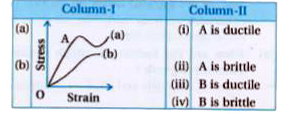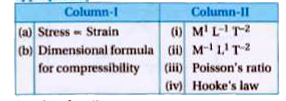Complete Solutions to SECTION-C of chapter MACHANICAL PROPERTIES OF SOLIDS of Class 11 book with complete answers and questions
| Class 11 | PHYSICS |
| Chapter | MACHANICAL PROPERTIES OF SOLIDS |
| KUMAR PRAKASHAN | SECTION-C |
| Number Of Questions | 66 |
| Academic Year | 2023-24 |
What is elasticity ? What is plastic body and plasticity?
View SolutionWhat is a perfectly plastic body?
View SolutionWhat is a perfectly plastic body?
View SolutionWhich is more elastic ? Rubber or steel?
View SolutionWhy is only rubber used to make cycle seat instead of wood or iron ?
View SolutionWhy do spring balances show wrong readings of weight after they have been used for a long time?
View SolutionGive three properties which have different magnitudes and also have different direction.
View SolutionIf under the external force, the chain in length `Deltal` occur in rod of length I then write the formula for longitudinal strain.
View SolutionWhat is stress ? Give its two definations.
View SolutionWrite the formula and unit of volume stress.
View SolutionCan volume stress be a pressure ?
View SolutionDefine shearing stress and write its formula.
View SolutionPressure and stress having same unit (and dimension) although they are not a same physical quantity, why ?
View SolutionWhat is the bulk modulus of a perfectly rigid body?
View SolutionWhat is the shape of graph of stress `to` strain upto elastic limit?
View SolutionWhat is the slope of graph of stress `to` strain upto elastic limit?
View SolutionWrite copper, steel, glass and rubber in the order of increasing coefficient of elasticity.
View SolutionGive an example of pure shear.
View SolutionGive difference between charge and mass.
View SolutionWhat is shear modulus for liquid ?
View SolutionWhy strain has no unit?
View SolutionWhich type of elastic modulus is there in liquid and gas ?
View Solution`0.1 Pa = ...... Nm^(-2) = ...... "dyne" cm^(-2).`
View SolutionAt every point of rest liquid, the tangential stress is zero. Explain with reason.
View SolutionWhich one is more elastic, steel or plastic ? Why ?
View SolutionWhy water is more elastic than air ?
View SolutionGive the value of shear modulus of sulfuric acid.
View SolutionA wire is hanged from the ceiling without any weight below it, would there any stress in the wire ?
View SolutionWhich of the following bulk modulus is possible in solid, liquid and gaseous ?
View SolutionA solid sphere of radius 10 cm is subjected to a pressure of `5 xx 10^(8) Nm ^(-2),` then determine the change in its volume. Bulk modulus of material of sphere is `3.14 xx 10 ^(11) Nm ^(-=2).`
View SolutionThe length of metallic wire is l. The tensin in the wire is `T_(1)` for length ` l_(1)` and tension in the wire is `T_(2)` for length `l_(2).` Find the original length.
View SolutionWhat is the effect of change in temperature on the Young's modulus ?
View SolutionDoes the energy stored in a spring changes when it stretched or compressed ?
View SolutionIs stress is a vector or scalar or tensor ?
View SolutionWhen the heavy weight suspended and removed from the metal wire, it cannot get original length. Why?
View SolutionName the property which opposes the deformation.
View SolutionWrite the limitation of Hooke's law.
View SolutionWhat are the factors on which modulus of elasticity depends ?
View SolutionTwo force are equal and opposite in direction exerted on a bar (rod) as shown in figure. Hence plane PQ makes an angle `theta` with the cross-section 'a'. Find the tensile stress on PQ.

View SolutionWeight is suspended to the end of elastic spring its increaed length depends upon what ?
View SolutionWhat is the bulk modulus of a perfectly rigid body?
View SolutionWhy do rail tracks have a 'I shaped girder ?
View SolutionIs it possible to double the length of a metallic wire by applying force over it ?
View SolutionA cable is cut to half of its original length. What will be the effect on the increase in its length under a given load ?
View SolutionWhen a stress of `10^(8) Nm ^(-2)` is applied to a suspended wire its length increases by 1 mm.
Calculate Young's modulus of wire.
View SolutionA metallic rod having area of cross section A, Young's modulus Y, coefficient of linar expansion `alpha` and length L tied with two strong pillars. If the rod is heated through a temperature `t ^(@)C` then how much force is produced in rod ?
View SolutionThe magnitude of Young's modulus proportonal to the increase in length.
View SolutionBreaking stress is known as elasticity.
View SolutionQuartxz is almost elastic body.
View SolutionWhat is shear modulus for liquid ?
View SolutionFor a given load (external force) steel is more deformed than rubber.
View SolutionWhen solid body beated, roled, heated or cooled its elastic properties affected.
View SolutionYoung's modulus of rigid body is …….
View SolutionA wire increase by `10 ^(-6) ` times its original length when a stress of `10 ^(8) Nm ^(-2)` is applied to it, calculate its Young's modulus.
View SolutionThe value of Poisson's ratio for steel is ……..
View SolutionIf a body breaks immediately after the elastic limit then this body is known as……
View SolutionAn elastic body which can be stretched to cause arge strains are called …..
View SolutionColumn-II is related to Column-I. join them appropriately :

View SolutionJoin details of Column-II with given information in Column-I appropriately :

View SolutionIn column-I there are two graphs and in Column-II whose graph is for this are given . Joun them appropriately :

View SolutionJoin the relation of physical quantities in Column-I to the details given in Column-II appropriately:

View SolutionA: Two wire A and B having equal cross sections made from the same material. The length of A is twice to the length of B, hence the increase in length of A is twice to the increase in length of B for a given same weight.
R: Increase in length of wire proportional to its length for a given same length.
View SolutionA: The stretching of a coil is determined by the shear modulus.
R: Share modulus change only shape of a body keeping its volume unchanged.
View SolutionA: Rubber is less elastic than steel.
R: Under given deforming force, steel is deformed less than ruber.
View SolutionA: The bridges declared unsafe after a long use.
R: Elastic strength of bridges increase with time.
View SolutionA: A thread of length L is streatched by a force of 5N, its length increases by a and stretched by force of 6N its length increases by b, now if it is stretched by force of 11 N its length increases by `(a + b -L).`
R: Increasing the length of elastic thread is proportional to its initial length.
View Solution
SECTION-C questions and complete solutions for chapter MACHANICAL PROPERTIES OF SOLIDS of KUMAR PRAKASHAN KENDRA PHYSICS (GUJRATI ENGLISH) of Class 11